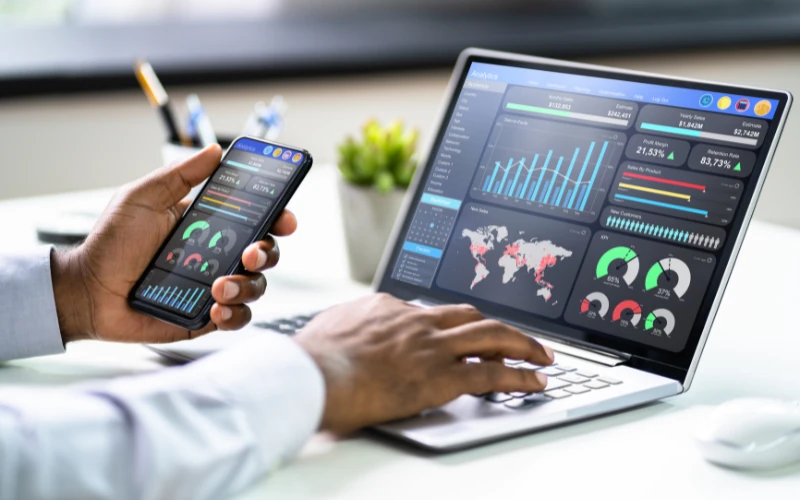Disclaimer: The information in this article is for general informational purposes only and should not be considered as professional medical advice or guidance. Readers should consult with qualified healthcare professionals or experts in telemedicine for personalized recommendations.
According to the CDC, telemedicine refers to the utilization of electronic information and telecommunication technology to provide patient care remotely, eliminating the need for in-person visits. Traditionally, telemedicine has been instrumental in bridging the gap for patients residing in rural areas, where access to healthcare services is limited due to geographical barriers and transportation challenges. However, with the rapid proliferation of wireless connectivity and technological advancements, telemedicine has evolved into a widely adopted approach for delivering efficient and cost-effective healthcare solutions.
This article explores the transformative power of telemedicine, from its traditional role in bridging healthcare gaps for rural populations to its current evolution as a widely adopted solution for efficient and cost-effective remote patient care, including remote patient monitoring, driven by advancements in wireless connectivity and technology.
Big Data and Data Analytics in Healthcare?
In the healthcare industry, “big data” refers to the vast amount of data generated by utilizing advanced technology in collecting patients’ data to aid in the delivery of care.
Big data analytics, on the other hand, is a term that refers to the practice of utilizing advanced analytical techniques to process large volumes of data at high velocity and a diverse range of data types, including structured, semi-structured, and unstructured data from a variety of sources and in sizes ranging from terabytes to zettabytes.
The healthcare industry benefited from big data analytics because it enabled better and faster decision-making, modeling and prediction of future outcomes, and greater healthcare intelligence. Here are 5 benefits of big data analytics in telemedicine.
5 Benefits of Big Data Analytics in Telemedicine:
1. Early identification and prevention of Communicable Diseases
Communicable diseases, like COVID-19, if not detected early and prevented from spreading, may put the whole world on lockdown. However, with the use of big data analytics, communicable diseases can be prevented and identified at their earliest. The application of deep learning algorithms to healthcare related data is vital to studying the patterns and trends of infectious diseases and their spread.
Big data searches and queries from the internet are used to better analyze and forecast the trends of communicable diseases. Also, from this data, infectious diseases may be identified and contained early. The moment the disease-infected areas are identified, telemedicine sets in. These areas may be quarantined to prevent the further spread of the disease. Also, with the use of telemedicine and remote patient monitoring (RPM), patients who are infected with the disease may receive continuous medication without endangering the lives of healthcare providers.
2. Better Diagnosis
Traditionally, patients’ health data is gathered through routine check-ups, patients’ visits to medical facilities, and what the patients tell their providers. While this is a good foundation, healthcare providers may be left with insufficient or inaccurate health information to correctly diagnose their patients, which will eventually lead to injury or worse, death. In fact, the NCBI reports that the overall rate of misdiagnosis is roughly 10% to 15%, resulting in 40,000 to 80,000 deaths or injuries annually.
Today, with the use of telemedicine and analytical algorithms, healthcare providers need not rely on what their patients tell them but rather on the data collected by their wearables. Since telemedicine allows continuous collection of data, healthcare providers are given sufficient data to better diagnose and understand their patients.
3. Post-treatment monitoring and medication
Traditionally, the best care is delivered in the hospital or in a medical facility. As such, when patients are discharged from the hospital, they are less likely to receive the same quality of care they received in the hospital. This sometimes results in unwarranted hospital re-admission. However, this scenario is no longer true due to the advancement of technology applied to healthcare.
When patients are discharged from the hospital, they will receive the same or better quality of care through telemedicine. Patients get to enjoy remaining in the comfort of their homes while being monitored remotely. Patients’ data are continuously collected using wearables or medical devices. And, with the use of data analytics, information regarding the condition of the patients is generated helping healthcare providers deliver better post-treatment monitoring and medication.
Furthermore, data obtained via the patients’ wearables and medical devices are analyzed using analytics techniques to determine the most effective treatment for a certain patient as patients may have similar illnesses but may need a different approach of treatment.
4. Electronic Health Records (EHR) on the Cloud
Traditionally, patients’ information is written on papers and is stored in cabinets, creating a bottleneck to accessing them. However, with the growing number of patients and the demand for bigger and more accessible storage, some providers have resorted to the cloud. With the cloud, patients’ data can be accessed remotely.
Furthermore, the EHR powered by cloud data analytics enables providers to deliver timely information and customize reports. Providers can also discover patterns and trends, such as why patients taking a certain medication are experiencing high blood pressure. As such, providers can modify their patients’ medications immediately. With this, providers do not need to go to the hospital and look at their patients’ files to discover that something might be wrong, but rather they can access that data anytime and anywhere.
Also, secure access to the cloud eliminates geographic location as a factor in obtaining the best treatment possible. It benefits healthcare providers as it enables more efficient scheduling of appointments, hence boosting the effectiveness of care. Cloud storage is both a forerunner to and a facilitator of the advent of big data.
5. Predictive Analytics
One of the greatest contributions of big data in telemedicine is the early detection of potential health concerns before they deteriorate into worsening diseases. This has become a reality with the development of the Internet of Medical Things (IoMT), which enables the collection of real-time patient data via wearables and other health monitoring devices. Data obtained from these wearables is utilized to do predictive analytics on possible future outcomes. Acquiring data from multiple sources is critical for identifying people who are at high risk of developing chronic diseases early in the disease’s progression.
Healthcare analytics provide new information to health providers, which is processed and validated by skilled data scientists, allowing them to make more accurate diagnoses and recommend the best treatment regimens. The future is more promising, since predictive and prescriptive analytics enable the prediction and monitoring of disease rather than only its detection. The data evaluated can come from claims data, electronic medical records (EMRs), and even real-time health sources such as wearables and mobile apps that track vital signs, providing a more complete picture of the patient’s health condition.
Big Data Analytics in Telemedicine: Revolutionizing Healthcare Delivery
Big data analytics plays a pivotal role in transforming the landscape of telemedicine, enabling healthcare providers to deliver efficient and effective remote healthcare services. Here are some key points highlighting the significance of big data analytics in telemedicine:
- Enhanced diagnostic accuracy: Big data analytics allows for the analysis of vast amounts of patient data, enabling healthcare providers to make more accurate diagnoses remotely.
- Personalized treatment plans: By analyzing patient data, including medical history, demographics, and lifestyle factors, big data analytics helps tailor treatment plans to individual patient needs, improving treatment outcomes.
- Optimized resource allocation: Big data analytics enables healthcare providers to optimize resource allocation by identifying areas with the highest demand for telemedicine services and allocating resources accordingly.
- Improved patient outcomes: Through data analysis, healthcare providers can identify trends and patterns in patient data, allowing for early intervention and personalized care, ultimately leading to improved patient outcomes.
- Informed decision-making: Big data analytics empowers healthcare providers with valuable insights derived from comprehensive data analysis, enabling them to make informed decisions about patient care and treatment strategies.
- Driving innovation: The integration of big data analytics into telemedicine drives innovation in remote healthcare delivery, leading to continuous improvements in patient care and healthcare outcomes.

Frequently Asked Questions
What is big data analytics in telemedicine?
Big data analytics in telemedicine refers to the use of advanced analytical techniques to process large volumes of healthcare data collected remotely, enabling healthcare providers to derive valuable insights and improve patient care delivery.
How does big data analytics benefit telemedicine?
Big data analytics in telemedicine offers numerous benefits, including early identification and prevention of communicable diseases, better diagnosis through continuous monitoring, post-treatment monitoring and medication optimization, cloud-based electronic health records for improved accessibility, and predictive analytics for early intervention and personalized treatment planning.
What role does real-time health data play in patient engagement?
Real-time health data accessible through wearables and health monitoring devices empowers patients to take a more active role in managing their health. It allows them to track vital signs, monitor progress, and make informed decisions about their healthcare journey.
How does big data analytics personalize treatment plans in telemedicine?
Big data analytics enables healthcare providers to analyze individual patient data and preferences, allowing for personalized treatment plans and interventions. This tailored approach enhances patient engagement and satisfaction, leading to better health outcomes.
What features do telemedicine platforms offer to enhance patient communication and accessibility?
Telemedicine platforms often include patient portals and secure messaging features, facilitating seamless communication between patients and healthcare providers. This promotes convenience and accessibility to healthcare services, allowing patients to easily access medical records, schedule appointments, and communicate with providers from the comfort of their homes.
Unlocking Telemedicine’s Potential with DrKumo RPM Solution
In the telemedicine era, DrKumo RPM solution pioneers big data analytics to transform healthcare. Leveraging advanced analytics, it maximizes five key benefits in telemedicine, enhancing diagnostic accuracy, personalizing treatment, optimizing resource allocation, and improving patient outcomes. Through comprehensive data analysis, DrKumo RPM solution empowers providers with valuable insights, driving innovation in remote healthcare delivery.
Takeaways
The combination of big data analytics and telemedicine gives providers data-driven insights to help them provide better treatment to patients. It promotes value-based health care delivery while also lowering costs. Apart from the aforementioned benefits, big data analytics has enabled the development of numerous new possibilities in the field of medicine that were previously deemed unattainable. The latest advancements in telemedicine are merely the tip of the iceberg, since there is a vast world of potential yet to be discovered in the field of telemedicine.
Embrace the future of healthcare by harnessing the power of big data analytics and telemedicine. By leveraging data-driven insights, providers can offer superior treatment to patients while promoting value-based healthcare delivery and reducing costs. Beyond these benefits, the marriage of big data analytics and telemedicine has unlocked countless new possibilities in medicine, propelling the field into uncharted territories of innovation and discovery.
Don’t wait to explore this vast world of potential in telemedicine. Contact us today!









